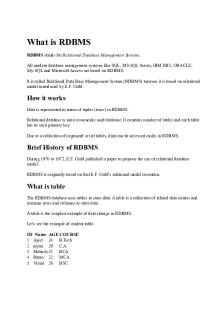Lecture 5- relational communications PDF

| Title | Lecture 5- relational communications |
|---|---|
| Course | Introduction to Communication |
| Institution | University of Ontario Institute of Technology |
| Pages | 3 |
| File Size | 102.2 KB |
| File Type | |
| Total Downloads | 45 |
| Total Views | 130 |
Summary
Lecture 5- relational communications
Topics covered: Burgoon & Hale, contect, problem statements, literature reviews, relational stages, interpersonal repair, theories, attraction theory, social exchange theory, equity...
Description
Lecture 5- Relational Communication “mom always liked you best” Burgoon & Hale • Academic pedigrees- research you relate to, • The research you build your ideas with. • Defined relational communication- they made it a specialized thing in communications • 1984 – 2019 Context • Messages within the context of a relationship • Johari window examples • How different kinds of relationships influence interactions Problem Statements • What was the problem Anderson & Emmers-Sommers were trying to solve? • 1984 Burgoon & Hale - 12 dimensions • 2019 Political theory lacks depth in small group settings and political decision-making. What it is Not • Not HOW to do the project • NOT broad or vague • NOT a value statement • It is a clear and concise statement that shows commitment to your topic and you’ve done your homework Types? - Difference problem - Descriptive problem - Relational problem Literature reviews - Traces the relevant research - Not descriptions, popular press, blogs, dictionaries - Only pertain to research - citations What ARE They Then? What the heck are “the Literature”? Major works about a narrow topic- when you see the same things over and over again What is a “Review”? Snapshot major concepts With the relationships between literature So What? 1. Prove your own understanding 2. Demonstrating your knowledge
3. Updating your reader Relational Communication Relational Stages 1. Maintenance- the work you do to keep the relationship alive 2. Dissolution 3. Repair 4. Development 5. Deterioration - You can move through all the stages; no specific order Interpersonal Repair (repair wheel) - Acknowledge the risks - Recognize the problem - Productive conflict resolution - Propose possible solutions - Affirm each other - Integrate solution into everyday behaviour - Acknowledge the risks Theories • Attraction Theory:Berger & Calabrese (1975) • Social Exchange: Thibault & Kelly (1959) • Equity: John S Adams (1975) Attraction theory • Physical- romantic or bffs – brunette, tall • Proximity- closeness- they seem to be everywhere • Similarity- similarities between the two, same favourite sports team Social Exchange • Group interactions • Maximizing profits • Tipping the scales in your favour • According to the social exchange theory, humans weigh the costs against benefits while forming relationships Equity - Rewards and costs - Equal partners - Perceptual theory - Similar to social exchange but its equal...
Similar Free PDFs

Oral Communications Module 5
- 2 Pages

Relational Turbulence Theory
- 2 Pages

Relational Communication
- 11 Pages

Relational dialectics
- 23 Pages

Cellular Communications
- 1,036 Pages

Marketing communications
- 11 Pages

Relational Development Challenges
- 10 Pages

Rdbms - relational databases
- 4 Pages

Relational Aesthetics Summary
- 2 Pages
Popular Institutions
- Tinajero National High School - Annex
- Politeknik Caltex Riau
- Yokohama City University
- SGT University
- University of Al-Qadisiyah
- Divine Word College of Vigan
- Techniek College Rotterdam
- Universidade de Santiago
- Universiti Teknologi MARA Cawangan Johor Kampus Pasir Gudang
- Poltekkes Kemenkes Yogyakarta
- Baguio City National High School
- Colegio san marcos
- preparatoria uno
- Centro de Bachillerato Tecnológico Industrial y de Servicios No. 107
- Dalian Maritime University
- Quang Trung Secondary School
- Colegio Tecnológico en Informática
- Corporación Regional de Educación Superior
- Grupo CEDVA
- Dar Al Uloom University
- Centro de Estudios Preuniversitarios de la Universidad Nacional de Ingeniería
- 上智大学
- Aakash International School, Nuna Majara
- San Felipe Neri Catholic School
- Kang Chiao International School - New Taipei City
- Misamis Occidental National High School
- Institución Educativa Escuela Normal Juan Ladrilleros
- Kolehiyo ng Pantukan
- Batanes State College
- Instituto Continental
- Sekolah Menengah Kejuruan Kesehatan Kaltara (Tarakan)
- Colegio de La Inmaculada Concepcion - Cebu






